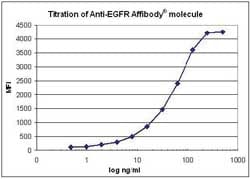Anti-EGFR Affibody® Molecule FITC (ab81872)
Overview
-
Product name
Anti-EGFR Affibody® Molecule FITC
See all EGFR affibody® molecule -
Conjugation
FITC. Ex: 493nm, Em: 528nm -
Conjugation notes
The molecule is conjugated at the unique C-terminal cysteine using a maleimide activated fluorescein reagent. Stability: There is no decrease in performance of the fluorescein conjugated Affibody® molecule after 10 repeated freeze and thaw cycles or after storage for 1 week in room temperature. -
Specificity
This product binds to human EGFR. This anti-EGFR Affibody® molecule is a specific affinity ligand selected against the extracellular domain of EGFR. The FITC conjugated Anti-EGFR Affibody® molecule is excellent as a one step reagent for fluorescence studies of EGFR expression on cells as well as for flow cytometry. -
Tested applications
Suitable for: Flow Cyt, ICC/IFmore details
Unsuitable for: IHC-P -
Species reactivity
Reacts with: Human -
Immunogen
Other Immunogen Type corresponding to EGFR.
-
Positive control
A431 cells. -
General notes
This product is a recombinant protein produced in E.coli.
Properties
-
Form
Liquid -
Storage instructions
Shipped at 4°C. Upon delivery aliquot and store at -20°C. Avoid repeated freeze / thaw cycles. -
Storage buffer
pH: 7.20
Preservative: 0.02% Sodium azide
Constituents: 0.87% Sodium chloride, 0.328% Sodium phosphate -
 Concentration information loading...
Concentration information loading... -
Purification notes
Purity: >98% as determined by RP-HPLC analysis. Extinction coefficient: 1 Abs280 = 1.30 mg/ml. -
Research areas
-
Function
Receptor tyrosine kinase binding ligands of the EGF family and activating several signaling cascades to convert extracellular cues into appropriate cellular responses. Known ligands include EGF, TGFA/TGF-alpha, amphiregulin, epigen/EPGN, BTC/betacellulin, epiregulin/EREG and HBEGF/heparin-binding EGF. Ligand binding triggers receptor homo- and/or heterodimerization and autophosphorylation on key cytoplasmic residues. The phosphorylated receptor recruits adapter proteins like GRB2 which in turn activates complex downstream signaling cascades. Activates at least 4 major downstream signaling cascades including the RAS-RAF-MEK-ERK, PI3 kinase-AKT, PLCgamma-PKC and STATs modules. May also activate the NF-kappa-B signaling cascade. Also directly phosphorylates other proteins like RGS16, activating its GTPase activity and probably coupling the EGF receptor signaling to the G protein-coupled receptor signaling. Also phosphorylates MUC1 and increases its interaction with SRC and CTNNB1/beta-catenin.
Isoform 2 may act as an antagonist of EGF action. -
Tissue specificity
Ubiquitously expressed. Isoform 2 is also expressed in ovarian cancers. -
Involvement in disease
Lung cancer
Inflammatory skin and bowel disease, neonatal, 2 -
Sequence similarities
Belongs to the protein kinase superfamily. Tyr protein kinase family. EGF receptor subfamily.
Contains 1 protein kinase domain. -
Post-translational
modificationsPhosphorylation at Ser-695 is partial and occurs only if Thr-693 is phosphorylated. Phosphorylation at Thr-678 and Thr-693 by PRKD1 inhibits EGF-induced MAPK8/JNK1 activation. Dephosphorylation by PTPRJ prevents endocytosis and stabilizes the receptor at the plasma membrane. Autophosphorylation at Tyr-1197 is stimulated by methylation at Arg-1199 and enhances interaction with PTPN6. Autophosphorylation at Tyr-1092 and/or Tyr-1110 recruits STAT3. Dephosphorylated by PTPN1 and PTPN2.
Monoubiquitinated and polyubiquitinated upon EGF stimulation; which does not affect tyrosine kinase activity or signaling capacity but may play a role in lysosomal targeting. Polyubiquitin linkage is mainly through 'Lys-63', but linkage through 'Lys-48', 'Lys-11' and 'Lys-29' also occurs. Deubiquitination by OTUD7B prevents degradation. Ubiquitinated by RNF115 and RNF126.
Methylated. Methylation at Arg-1199 by PRMT5 stimulates phosphorylation at Tyr-1197. -
Cellular localization
Secreted and Cell membrane. Endoplasmic reticulum membrane. Golgi apparatus membrane. Nucleus membrane. Endosome. Endosome membrane. Nucleus. In response to EGF, translocated from the cell membrane to the nucleus via Golgi and ER. Endocytosed upon activation by ligand. Colocalized with GPER1 in the nucleus of estrogen agonist-induced cancer-associated fibroblasts (CAF). - Information by UniProt
-
Alternative names
- Avian erythroblastic leukemia viral (v erb b) oncogene homolog
- Cell growth inhibiting protein 40
- Cell proliferation inducing protein 61
see all -
Database links
- Entrez Gene: 1956 Human
- Omim: 131550 Human
- SwissProt: P00533 Human
- Unigene: 488293 Human
- Unigene: 605083 Human
Images
-
Fluorescence histogram from flow cytometry analysis on EGFR expressing A431 cells. Staining with ab81872 caused an increase in fluorescence intensity as shown by a shift to the right (red line) compared to control (black line).
-
Titration diagram from cytometry analysis of EGFR expressing A431 cells. ab81872 was titrated on EGFR expressing A431 cells. The concentration was plotted against the mean fluorescence intensity (MFI).
-
A431 cells were stained with ab81872 at 2µg/ml by Immunofluorescence. The staining was localized to the membrane of the EGFR-expressing A431 cells. The nuclei were counter stained with DAPI.


















